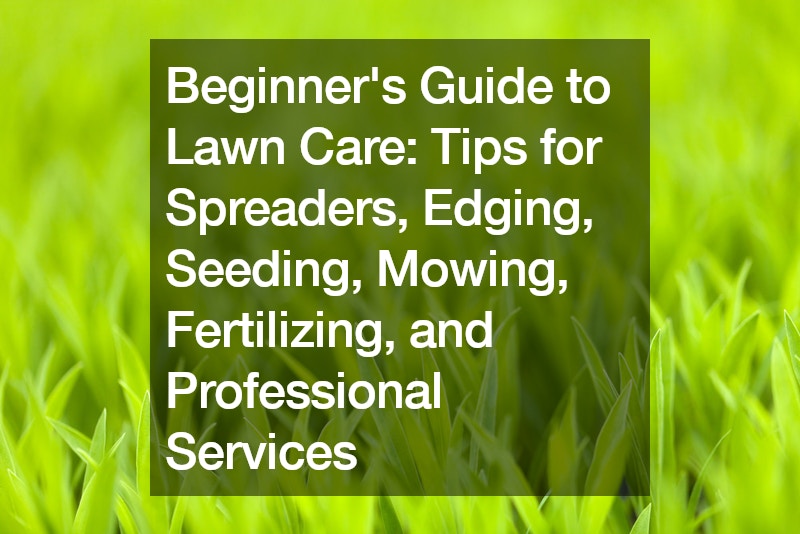
Achieving a lush, vibrant lawn is a goal for many homeowners, but it often feels like a daunting task, especially for beginners. However, with the right knowledge and tools, lawn maintenance can be a manageable and rewarding endeavor. In this essential guide, we’ll explore key tips for spreaders, edging, seeding, mowing, fertilizing, and also touch upon the advantages of hiring professional lawn maintenance services.
Spreaders: Choose Wisely
When it comes to spreading fertilizers and other lawn care products, the type of spreader you use can make a significant difference in the results. Many beginners opt for inexpensive plastic spreaders from their local Big Box store, assuming they’re a cost-effective solution. However, these spreaders often come with drawbacks, such as leaving unsightly fertilizer stripes on the lawn.
One common issue with certain spreaders, including some popular brands, is the use of hollow wheels. Fertilizer can accumulate in these hollow spaces, leading to uneven distribution and visible streaks on the lawn. Additionally, some users report difficulty in keeping the fertilizer in the hopper, resulting in wastage and further striping.
To avoid these pitfalls, opt for spreaders with full plastic or rubber wheels. While they may come at a slightly higher cost, they offer more consistent performance and better results. Investing in a quality spreader from the outset can save you time, effort, and frustration in the long run.
Edging: Define Your Lawn’s Boundaries
Creating clean, well-defined edges can enhance the overall appearance of your lawn, giving it a polished and manicured look. Edging involves creating a distinct boundary between your lawn and other surfaces, such as driveways or sidewalks. Think of it as giving your lawn a haircut and outlining its neckline for a neat and tidy appearance.
Specialized edging tools are available for this purpose, ranging from expensive models to more budget-friendly options. While pricier edgers may offer superior performance, even affordable models can achieve satisfactory results with proper technique.
Seeding: Timing and Technique Matter
Seeding is a crucial step in maintaining a healthy lawn, but it’s essential to do it right, especially for beginners. Timing is key, particularly for cool-season grasses, which thrive when seeded in the fall. Spring seeding can be challenging due to increased stress and heat during the summer months, making it less likely for new grass to survive.
Another common mistake is neglecting to keep the seed moist during germination. Proper watering is essential for seed viability and establishment. Avoid the temptation to water only once after seeding and forgetting about it. Instead, maintain consistent moisture until the grass begins to grow.
When selecting seed, opt for high-quality varieties to avoid introducing unwanted weeds to your lawn. Big Box store blends may contain inferior seed mixtures, potentially causing issues down the line. Investing in premium seed ensures better germination rates and long-term lawn health.
Mowing: Consistency is Key
Regular mowing is vital for maintaining a healthy and attractive lawn. Many homeowners make the mistake of waiting until the grass is excessively long before mowing, leading to scalping and stress on the grass plants. Instead, establish a consistent mowing schedule, aiming to cut no more than one-third of the grass height each time.
Mowing at the correct height–typically between three and four inches–encourages deeper root growth and helps the grass withstand heat and drought stress. By mowing frequently and at the right height, you’ll promote a dense, resilient lawn that can better compete with weeds and withstand environmental challenges.
Fertilizing: Choose the Right Products
Fertilizing provides essential nutrients that support healthy lawn growth, but it’s essential to select the right products for your needs. For beginners, a four-step fertilizer program offers a straightforward approach to lawn care, providing specific products for each season and clear instructions for application.
Alternatively, slow-release fertilizers are an excellent option for beginners, as they release nutrients gradually over time, reducing the risk of over-fertilization and lawn damage. Unlike fast-release fertilizers, which require precise timing and application rates, slow-release formulas are more forgiving and easier to manage.
Importance of Hiring Lawn Maintenance Service
While the DIY approach to lawn care is admirable, there are instances where professional expertise becomes invaluable. Hiring a lawn maintenance service can bring a multitude of benefits, especially for those with time constraints or limited experience in lawn care.
Professional lawn maintenance services offer a level of expertise and efficiency that can elevate the health and aesthetics of your lawn. These professionals are equipped with the knowledge to identify specific needs, from soil conditions to pest control, and tailor their services accordingly. Their experience allows them to address issues promptly, preventing potential long-term damage to your lawn.
Moreover, lawn maintenance services often have access to high-quality equipment and fertilizers that may not be readily available to individual homeowners. This can result in more effective treatments and superior results for your lawn. The convenience of outsourcing lawn care also frees up your time, allowing you to focus on other aspects of homeownership or simply enjoy your outdoor space without the hassle of extensive maintenance.
In conclusion, achieving a beautiful lawn doesn’t have to be overwhelming for beginners. By following these essential tips for spreaders, edging, seeding, mowing, and fertilizing, you can lay the foundation for successful lawn maintenance. And, for those seeking an extra layer of care and expertise, considering professional lawn maintenance services might be the key to unlocking the full potential of your outdoor space.
.

